| Don’t just sit there! Build something!! |
Learning to mathematically analyze circuits requires much study and practice. Typically, students practice by working through lots of sample problems and checking their answers against those provided by the textbook or the instructor. While this is good, there is a much better way.
You will learn much more by actuallybuilding and analyzing real circuits, letting your test equipment provide the “answers” instead of a book or another person. For successful circuit-building exercises, follow these steps:
一种void very high and very low resistor values, to avoid measurement errors caused by meter “loading”. I recommend resistors between 1 kΩ and 100 kΩ, unless, of course, the purpose of the circuit is to illustrate the effects of meter loading!
一个方法你可以节省时间和减少possibility of error is to begin with a very simple circuit and incrementally add components to increase its complexity after each analysis, rather than building a whole new circuit for each practice problem. Another time-saving technique is to re-use the same components in a variety of different circuit configurations. This way, you won’t have to measure any component’s value more than once.
让电子本身给您解决自己的“练习问题”的答案!
It has been my experience that students require much practice with circuit analysis to become proficient. To this end, instructors usually provide their students with lots of practice problems to work through, and provide answers for students to check their work against. While this approach makes students proficient in circuit theory, it fails to fully educate them.
学生不仅需要数学实践。他们还需要真实的动手练习建筑电路并使用测试设备。因此,我建议采用以下替代方法:学生应该buildtheir own “practice problems” with real components, and try to mathematically predict the various voltage and current values. This way, the mathematical theory “comes alive,” and students gain practical proficiency they wouldn’t gain merely by solving equations.
一种nother reason for following this method of practice is to teach studentsscientific method:the process of testing a hypothesis (in this case, mathematical predictions) by performing a real experiment. Students will also develop real troubleshooting skills as they occasionally make circuit construction errors.
Spend a few moments of time with your class to review some of the “rules” for building circuits before they begin. Discuss these issues with your students in the same Socratic manner you would normally discuss the worksheet questions, rather than simply telling them what they should and should not do. I never cease to be amazed at how poorly students grasp instructions when presented in a typical lecture (instructor monologue) format!
一种note to those instructors who may complain about the “wasted” time required to have students build real circuits instead of just mathematically analyzing theoretical circuits:
学生参加您的课程的目的是什么?
If your students will be working with real circuits, then they should learn on real circuits whenever possible. If your goal is to educate theoretical physicists, then stick with abstract analysis, by all means! But most of us plan for our students to do something in the real world with the education we give them. The “wasted” time spent building real circuits will pay huge dividends when it comes time for them to apply their knowledge to practical problems.
Furthermore, having students build their own practice problems teaches them how to performprimary research,从而使他们有能力继续自主的电气/电子教育。雷竞技最新appraybet电子竞技竞猜
In most sciences, realistic experiments are much more difficult and expensive to set up than electrical circuits. Nuclear physics, biology, geology, and chemistry professors would just love to be able to have their students apply advanced mathematics to real experiments posing no safety hazard and costing less than a textbook. They can’t, but you can. Exploit the convenience inherent to your science, andget those students of yours practicing their math on lots of real circuits!
Calculate the output voltages of these two voltage divider circuits (V一种and Vb):

|
|
现在,计算点之间的电压一种(red lead) andb(黑线)(Vab)。
v一种=65.28 V
vb=23。26 V
vab=42。02v(point一种being positive relative to pointb)
挑战问题n: what would change if the wire connecting the twovoltage divider电路一起拆除了吗?

|
|
In this question, I want students to see how the voltage between the two dividers’ output terminals is the difference between their individual output voltages. I also want students to see the notation used to denote the voltages (use of subscripts, with an applied reference point of ground). Although voltage is永远永远a quantity between two points, it is appropriate to speak of voltage being ät” a single point in a circuit if there is an implied point of reference (ground).
可以解决Vabwithout formally appealing to Kirchhoff’s Voltage Law. One way I’ve found helpful to students is to envision the two voltages (V一种and Vb)as heights of objects, asking the question of “How much heightdifference两个对象之间有吗?”

|
|
The height of each object is analogous to the voltage dropped across each of the lower resistors in the voltage divider circuits. Like voltage, height is a quantity measured在两个点之间(the top of the object and ground level). Also like the voltage Vab, the difference in height between the two objects is a measurement taken between two points, and it is also found by subtraction.
Calculate the output voltages of these two voltage divider circuits (from point一种地面bto ground:

|
|
现在,计算点之间的电压一种(red lead) andb(black lead).
v一种=65.28 V
vb= 75.0 v
vab=-9.72 V
In this question, I want students to see how the voltage between the two dividers’ output terminals is the difference between their individual output voltages. I also want students to see the notation used to denote the voltages (use of subscripts, with an applied reference point of ground). Although voltage is永远永远a quantity between two points, it is appropriate to speak of voltage being ät” a single point in a circuit if there is an implied point of reference (ground).
在电阻r上需要滴多少电压1in order to make voltage Vabequal to zero?

|
|
How much resistance must R1possess in order to drop that amount of voltage?
vr1= 9 V
r1=20kΩ
Follow-up question: what do you notice about the fourresistors’ values in this condition where Vab=0? Pair up these four resistors into two sets of two pairs, and calculate the ratios of those pairs. What do you notice about these ratios?
The follow-up question regarding ratios is a good introduction to the fundamental principle of balanced bridge circuits. Having students work through the calculations together is a good way for them to see the principle for themselves.
It is also important to note in this circuit which ratios arenotin agreement with each other. You can’t just divide these four resistors into any set of two pairs and expect the ratios to equal each other! It is very important for students to see this, as well.
一种thermistoris a special resistor that dramatically changes resistance with changes in temperature. Consider the circuit shown below, with two identical thermistors:

|
|
The “ to透明label in each one shows that they both have positive α coefficients.
How much voltage would you expect the voltmeter to register when the two thermistors are at the exact same temperature? Which thermistor would have to become hotter in order to cause the voltmeter to read a significantnegative电压?
如果两个热敏电阻在相等的温度下voltmetershould register 0 volts. To get the voltmeter to register negative, the left-hand thermistor would have to be warmer than the right-hand thermistor.
This circuit may be viewed from the perspective of it being two voltage dividers, or from the perspective of being a current divider. Either way, it is a good exercise for you and your students to explore how it functions.
In general terms, describe what must be done tobalancethis bridge circuit. What, exactly, does the term “balance” mean in this context?

|
|
一种lso, write an equation containing only the four resistor values (R1, R2, R3和r4)showing their relationship to one another in a balanced condition.
For abridge circuit要“平衡”意味着电路的两个相对角之间的电压为零(电池在其中not)connect. Achieving a condition of “balance” in a bridge circuit requires that the resistance ratios of the four “arms” of the circuit be in proportion:
|
Follow-up question: the bridge-balance equation shown above may also be written in a slightly different form:
|
Show algebraically how the first equation may be manipulated to take the form of the second equation, thus demonstrating these two equations’ equivalence.
Challenge your students to write a “balance equation” describing how the ratios must relate to each other in order to achieve balance.
Identify the most important qualification for the “null” meter used to balance a bridge circuit. In other words, describe what type of meter we would be looking for if we were to select one for use as a “null” meter. Describe why this particular quality is important.
一种bove all, a null meter must besensitive。
与你的学生讨论“sens的定义itivity” with regard to meter movements, and why null meters have to be sensitive in order for the bridge circuit to be accurately balanced. If your students have studied meter movement design, you may wish to challenge them with a question on exactly how a null meter movement might be constructed (i.e. what would have to be done to maximize its sensitivity?).
What will happen to the voltage between points一种andbif the power supply voltage increases?

|
|
vab将保持与V相同supplyincreases.
This question highlights another important concept of bridge circuits, namely that balance is irrespective of supply voltage.
Explain how this bridge circuit is capable of being “balanced” foranyvalues of R1and R2:

|
|
The potentiometer acts as a complementary pair of resistors: moving the wiper one direction increases the value of one while decrease the value of the other. Thus, it forms a voltage divider with an infinitely adjustable division ratio of 0% to 100%, inclusive.
This question showcases one more use of the potentiometer: as a voltage divider used specifically to balance a bridge circuit for any arbitrary values of fixed resistances. If students have difficulty seeing how this is possible, you might want to try representing the pot as a pair of fixed resistors (R3and R4), the wiper position determining the balance of those two resistance values (Rpot=r1r2)。
Complete the wire connections necessary to make this a bridge circuit, where [(R1)/(r2)] = [(R3)/(r4在平衡):
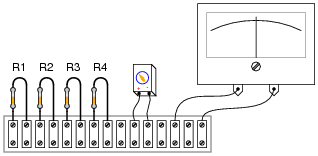
|
|
This, of course, is not the only way to connect the components to make a bridge circuit!

|
|
Challenge your students to connect the resistors in a manner different from the diagram shown in the answer, to make a bridge circuit. A good way to do this is to project an image of the original components (with no interconnections drawn) on a whiteboard with a video projector, then have students use dry-erase markers to draw the connecting wires in place. If any errors are made, they can be very easily erased without erasing any components themselves.
In the early days of electrical metrology, the best way to measure the value of an unknown resistance was to use abridgecircuit. Explain how a four-resistor bridge (a “Wheatstone” bridge) could be used to accurately measure an unknown resistance. What components would this bridge circuit have to be constructed from? Did the power source have to be precision as well? Did the voltmeter in the middle of the bridge have to be accurately calibrated?
这样的一座桥circuit needed to be built with three “standard” resistors, having precisely known resistances. At least one of these resistors needed to be adjustable, with a precision scale attached to it for indication of its resistance at any given position. The source (“excitation”) voltage did not not have to be precise, and the null meter only had to be sensitive and accurate at zero volts.
In the past I’ve lectured on Wheatstone bridges only to find a fair number of students completely misunderstanding the concept. The fact that a bridge circuit balances when the four arms’ resistances are in proportion is the easy part. What these students didn’t grasp is如何such a bridge might be used to actually measure an unknown resistance, or why it was not possible for them to build a laboratory-usable Wheatstone bridge circuit with the cheap resistors found in their parts kits.
例如,当被问及如何使用这样的桥梁电路时,听到学生回答说他们会使桥梁的一个可调节的臂之一回答并不罕见,then measure that arm of the bridge with their digitalohmmeterafter having achieved balancein order to calculate the unknown resistance by ratio. Though it may seem humorous to an instructor that someone might not realize the sheer existence of a precise ohmmeter would render the bridge circuit obsolete, it nevertheless revealed to me how foreign the concept of a Wheatstone bridge as a resistancemeasuringcircuit is to students working with modern test equipment. Such a technological “generation gap” is not to be underestimated!
In order for students to understand the practicality of a Wheatstone bridge, they need to realize that the only affordable calibration artifacts of the time were standard resistors and standard cells (mercury batteries).
一种应变仪是一种用于测量固体物体应变(压缩或膨胀)的设备,通过产生与应变量成正比的电阻变化。随着仪表的紧张,由于电线横截面和长度的变化,其电阻会略微改变。
The following strain gauge is shown connected in a “quarter-bridge” circuit (meaning only one-quarter of the bridge actively senses strain, while the other three-quarters of the bridge are fixed in resistance):

|
|
Explain what would happen to the voltage measured across this bridge circuit (Vab)if the strain gauge were to becompressed, assuming that the bridge begins in a balanced condition with no strain on the gauge.
The bridge circuit will become more unbalanced, with more strain experienced by the strain gauge. I will not tell you what the voltmeter’s极性但是,会!
请务必让您的学生解释他们如何在电压表终端中获得极性的答案。这是问题的最重要部分!
一种应变仪is a device used to measure the strain (compression or expansion) of a solid object by producing a resistance change proportional to the amount of strain:
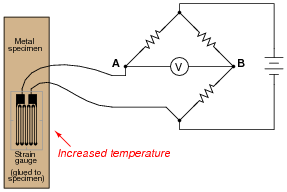
|
|
The bridge circuit is supposed to respond to changes in specimen strain, but explain what will happen to the voltage measured across this bridge circuit (Vab)if the specimen’s temperature increases (with no stress applied), assuming that the bridge begins in a balanced condition with no strain on the gauge, at room temperature. Assume a positive α value for the strain gauge conductors.
What does this indicate about the effectiveness of this device as a strain-measuring instrument?
If the specimen heats up, a voltage will develop between points一种andb, with一种保持积极和bbeing negative.
请务必让您的学生解释他们如何在电压表终端中获得极性的答案。
询问您的学生,该电路对温度的敏感性是否使其用作应变系统的使用无效。如果我们知道温度也会影响电路输出电压,是否不可能获得可靠的应变测量值?我们如何补偿温度对系统的影响?
预测由于以下故障的结果,预测该热敏电阻电路的运行将如何影响。独立考虑每个故障(即一次,没有多个故障):

|
|
For each of these conditions, explainwhythe resulting effects will occur.
这个问题的目的是从知道什么是故障的角度来处理电路故障排除的域,而不仅仅是知道症状是什么。尽管这不一定是现实的观点,但它可以帮助学生建立从经验数据中诊断出故障电路所必需的基本知识。诸如此类的问题(最终)应遵循其他问题,要求学生根据测量结果确定可能的错误。
预测测试点之间的电压极性一种andbwill be affected as a result of the following faults. Consider each fault independently (i.e. one at a time, no multiple faults):
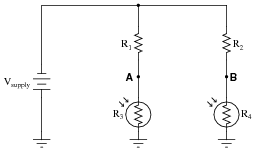
|
|
For each of these conditions, explainwhythe resulting effects will occur.
这个问题的目的是接近电路域troubleshootingfrom a perspective of knowing what the fault is, rather than only knowing what the symptoms are. Although this is not necessarily a realistic perspective, it helps students build the foundational knowledge necessary to diagnose a faulted circuit from empirical data. Questions such as this should be followed (eventually) by other questions asking students to identify likely faults based on measurements.
该桥电路应该产生与与该电路成正比的输出电压difference在两个光电器上的光线暴露之间:

|
|
However something has failed in this circuit, because the voltmeter is “pegged” fully negative and will not change with varying light exposures on the two cells. Identify at least two possible failures that could cause the voltmeter to over-range in the negative direction.
这是两个失败,尽管它们不是唯一的可能性:
be sure to ask your students to describe failuresotherthan the two mentioned in the answer. And, for all answers given, be sure to ask students how they determined those faults would cause the observed “negative pegging” of the voltmeter. As usual, the method of solution is much more important than the actual answer in this question.
Explain how this strain gauge circuit exploits a property of bridge circuits to provide automatic temperature compensation (so that changes in specimen temperature do not compromise strain measurement accuracy):
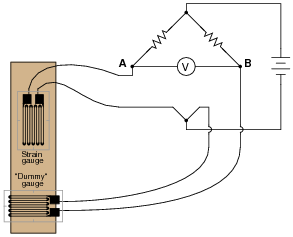
|
|
The “dummy” gauge is attached to the specimen in such a way that it is not subjected to strain like the “working” gauge is. It it merely exposed to the same specimen temperature. The action of this circuit is easiest to comprehend in a scenario where there is no stress applied to the specimen, but its temperature changes.
后续问题:假设“虚拟”应变量规会出现开放的故障,因此没有电流可以通过它。确定由于该故障而在电压表中会发展的电压降的极性。
因为天生桥电路differentialcircuits, it is possible to perform neat “tricks” such as this where the effects of the undesired influence (temperature) become canceled. Incidentally, the principle of cancellation by differential measurement is one that is very common in electronic systems, especially instrumentation systems.
The following bridge circuit uses two strain gauges (one to measure strain, the other to compensate for temperature changes), the amount of strain indicated by the voltmeter in the center of the bridge. Unfortunately, though, it has a problem. Instead of registering a very small voltage as it normally does, the voltmeter shows a large voltage difference, with point一种积极和点bnegative:

|
|
Something is wrong in the bridge circuit, because this voltage is present even when there is no physical stress on the specimen. Identify which of the following faults could cause the excessive voltage to appear across the voltmeter, and which could not. Consider only one of these faults at a time (no multiple, simultaneous faults):
Follow-up question: identify possible金属丝orconnectionfailures in this circuit which could cause the same symptom to manifest.
This question helps students build the skill of eliminating unlikely fault possibilities, allowing them to concentrate instead on what is more likely. An important skill in system troubleshooting is the ability to formulate probabilities for various fault scenarios. Without this skill, you will waste a lot of time looking for unlikely faults, thereby wasting time.
对于每一个足总ult scenario it is important to ask your studentswhythey think it is possible or not possible. It might be that some students get the right answer(s) for the wrong reasons, so it is good to explore the reasoning for each answer.
The following bridge circuit uses two strain gauges (one to measure strain, the other to compensate for temperature changes), the amount of strain indicated by the voltmeter in the center of the bridge. Unfortunately, though, it has a problem. Instead of registering a very small voltage as it normally does, the voltmeter shows a large voltage difference, with pointb积极和点一种negative:
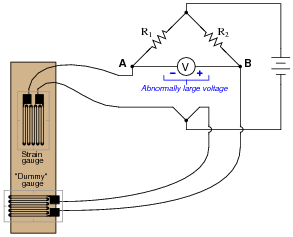
|
|
Something is wrong in the bridge circuit, because this voltage is present even when there is no physical stress on the specimen. Identify which of the following faults could cause the excessive voltage to appear across the voltmeter, and which could not. Consider only one of these faults at a time (no multiple, simultaneous faults):
Follow-up question: identify possible金属丝orconnectionfailures in this circuit which could cause the same symptom to manifest.
This question helps students build the skill of eliminating unlikely fault possibilities, allowing them to concentrate instead on what is more likely. An important skill in system troubleshooting is the ability to formulate probabilities for various fault scenarios. Without this skill, you will waste a lot of time looking for unlikely faults, thereby wasting time.
对于每一个足总ult scenario it is important to ask your studentswhythey think it is possible or not possible. It might be that some students get the right answer(s) for the wrong reasons, so it is good to explore the reasoning for each answer.
Published under the terms and conditions of the创作共用一种ttribution License

经过bourns




经过bourns